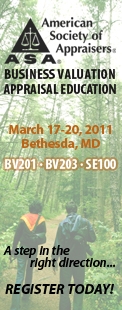
| March 1, 2011 | Issue #102-1 | Forward to a Friend |
Damodaran updates his Equity Risk Premiums article Professor Aswath Damodaran (Stern School of Business, New York) has recently updated his article titled “Equity Risk Premiums (ERP): Determinants, Estimation and Implications.” The 94-page 2011 edition provides a detailed picture of ERPs. He provides highlights of the article on his blog, Musings on Markets. Some of his thoughts and findings on the subject include:
Survey: Are law firms hiring their BV experts later than ever? We’d appreciate a few minutes of your time in answering a brief survey: 1. Are you seeing a trend toward law firms hiring later and later? 2. If yes, have you found any ways to counter this trend. Click here to take the survey. We’ll publish the responses (anonymously if preferred!) in next week’s BVWire. After Uniloc: Has the Federal Circuit taken its tough stance on patent infringement damages The recent Uniloc U.S.A. v. Microsoft Corp. decision—in which the U.S. Court of Appeals for the Federal Circuit abolished the 25% rule of thumb in patent infringement cases—didn’t surprise many IP damages experts. The Federal Circuit first began signaling its tougher stance in 2009, in Lucent Technologies, Inc. v. Gateway. In considering a reasonable royalty rate derived from the parties’ hypothetical negotiation, the court confirmed that it would “exercise vigilance” to make sure an expert has relied on actual licensing agreements with clear links to the claimed invention: The law does not require an expert to convey all his knowledge to the jury about each license agreement in evidence, but a . . . damages award cannot stand solely on evidence which amounts to little more than a recitation of royalty numbers, one of which is arguably in the ballpark of the jury's award, particularly when it is doubtful that the technology of those license agreements is in any way similar to the technology being litigated here. After Lucent, the Federal Circuit decided ResQnet.com v. Lansa (2010), in which it rejected an expert’s calculations because he used “licenses with no relationship to the claimed invention to drive the royalty rate up to unjustified levels.” (A strong dissent criticized the decision for taking the Lucent standard to “untenable” levels, resulting in a “new rule whereby no licenses involving the patented technology can be considered in determining the value of the infringement, if the patents themselves are not directly licensed” or if the licenses include additional products. Nevertheless, four months later, in Wordtech Systems v. Integrated Network Solutions (2010), the court rejected licenses that provided “no basis of comparison” to actual sales and amounted to “little more than a recitation of royalty numbers.” What now for IP and damages experts? By “setting such strict barriers as to what evidence can be considered,” as the ResQnet.com dissent asserted, has the Federal Circuit left the damages analysis “without access to relevant information”? Find out next Wednesday, March 9, when David Jarczyk (ktMINE) will address the new rules in BVR’s next webinar, “Finding & Analyzing Royalty Rates.” Topics will include benchmarking intangible assets, how to utilize available (and appropriate) licensing information, and how to analyze licensing terms. To find out more and to register, click here. Chris Mercer: “There is pent-up transactional need out there” In his recent blog post “Pent-Up Transactional Need or Demand?,” Chris Mercer (Mercer Capital) wrote that the need to transfer or liquefy massive wealth held in private companies is substantially greater in early 2011 than it was during 2004-2007. Why? “Because little happened in the intervening years of financial crisis,” he says. Baby boomer business owners can take advantage of improving transactional markets and sell their businesses or prepare their businesses for sale, install an ESOP, engage in a leveraged recapitalization, or consider a special dividend to reduce excess assets. “If you are an adviser to business owners, now would be a good time to schedule meetings with your Baby Boomer clients to bring up the issues involved with intergenerational wealth transfers one more time,” he adds. Robert Reilly to testify to the DOL on behalf of the AICPA Robert Reilly (Willamette Management Associates) will provide testimony at a U.S. Department of Labor (DOL) public hearing on the proposed rule that would consider business appraisers who value sponsor company stock for employee benefit plan purposes as fiduciaries. Reilly is testifying on behalf on the AICPA, whose recommendations address the DOL concern regarding the quality of employee benefit plan valuations. The AICPA recommends that such valuations:
“A DOL rule that requires that sponsor company valuations be performed by credentialed professionals in compliance with promulgated valuation standards can only benefit plan participants,” Reilly says. Put all your critical assumptions in one place in your valuation reports That's a suggestion in Rod Burkert's most recent post in his Standard of Value blog. In his list of nine ways to improve the quality of your valuation reports, he suggests including a section on critical assumptions.
Duff & Phelps Risk Premium Report 2011 webinar this Thursday Don’t forget to join Roger Grabowski tomorrow, (March 3) for “The Duff & Phelps Risk Premium Report 2011.” This one-hour webinar will feature the author of the Duff & Phelps Risk Premium Report on the collection, analysis, and utilization of the data in this all-important publication. Purchase of the 2011 Report or the Duff & Phelps Risk Premium Calculator automatically registers you for this webinar. Click here for more information or to register. Another free resource from BVR: Watch Calculator co-creator James Harrington's live tour of the new Duff & Phelps Risk Premium Calculator. Download the free “Introducing the Duff & Phelps Risk Premium Calculator” video from the BVR website. Quackenbush offers a checklist for reliable management forecasts What makes jurors believe one expert witness over another? “Applying the rational model of law, we would like to think that jurors would evaluate the credentials, the methodology, and the strength of the conclusions offered, and compare the competing experts based upon the appropriate standards of the field. That would be rational, but alas, not really typical in the courtroom,” says Dr. Ken Broda-Bahm in his article “When Crossing or Responding to Your Opposing Expert Witness,” Look for the L.I.E.” L.I.E. stands for “Large Internal Error” and that is what attorneys look for to cut down opposing experts credibility. According to Broda-Bahm, L.I.Es are:
How many full time business appraisers are there? Jeff Hooke (Hooke Associates) recently posed a question in LinkedIn’s Business Valuation Professionals group: “Does anyone have an estimate of the number of full time business appraisers in the US? I think it's around 10,000.” Seth Webber (Berry Dunn McNeil & Parker) responded “the definition of ‘full time’ will be problematic” because many business appraisers “spend less than 50% of their professional time doing appraisal work, instead focusing on accounting, taxes, working as a business broker, etc.” Rod Burkert (Burkert Valuation Advisors) provided updated association members as a starting point:
David Foster, who compiles BVR’s 2011 Firm Economics and Best Practices Survey (due out this month) says he thinks there are about 6,500 fulltime appraisers in North America. “Many members of the leading associations do ten or fewer engagements a year and earn less than $60,000 a year from these projects, making them less than fulltime,” he comments. “And about 20% of respondents this year have memberships in more than one valuation association.” Do you have any insight into the number of full time business appraisers. Email us with your thoughts, or join the LinkedIn group discussion! Appraisal Standards Board seeks comments on proposed USPAP changes The Appraisal Standards Board (ASB) is considering changes for the Fifth Exposure Draft of Proposed Changes to the 2012-13 Edition of the Uniform Standards of Professional Appraisal Practice. The ASB requests your comments and feedback by April 1, 2011. Submit written comments on this exposure draft by mail, email and facsimile:
NACVA and IBA members approve standards unification Matt Stelzman (Henderson Hutcherson & McCullough) was one of the first to highlight, on his blog Business Valuation Insight, that NACVA and IBA memberships’ ratified the new principles-based standards developed jointly by a team representing both organizations. “ This represents “one giant leap” for the business valuation community at large,” writes Stelzman. The standards become effective June 1, 2011. An interview with IBA executive director Howard Lewis about the new standards will appear in the April issue of Business Valuation Update. Software company exit valuations up sharply According to a recent Software Equity Group report:
The executive summary is available here. Registration is required. Pepperdine Private Capital Markets Project requests your input John Paglia (Pepperdine University) is conducting a research survey on “privately-held companies and the markets in which they raise capital.” Your individual responses will be kept confidential, and for participating in the survey you will receive a complimentary report on business financing and private capital markets in advance of general distribution. Complete the survey here. The survey is open until March 12th. CalCPA’s one day Business Valuation Conference is scheduled for June 3, 2011 in San Francisco. The entire day is focused on Company Specific Risk, featuring speakers such as Warren Miller and James Harrington (Duff and Phelps). Positive outlook for restaurants bodes well for appraisers After noting a second Restaurant Finance Conference just 4 months after the November conference, restaurant valuation expert Ed Moran told BVWire “this heavily attended event is a lighthouse for activity in the restaurant industry. Valuators will see increased demand for their services from this industry, if my crystal ball is correct.” The extension of the aggressive tax benefits, including capital expenditures, the SBA credit expansion, lender funding increases, and private equity - investor interest are increasing restaurant expansion and acquisition. However, gas and commodity price uncertainties may temper growth, he adds. “The fast/casual segment, which includes Panera Bread and Chipotle Mexican Grill, appear to be the current industry ‘growth engine,’ but investors are also worried whether the industry can meet their inflated expectations.” For up to date current information on the state of the full service restaurant industry and sales of recent companies, check the new BVR's Industry Transaction & Profile Annual Report on Full Service Restaurants. Finally, for detailed advice on restaurant valuation, check out Ed Moran’s BVR's Guide to Restaurant Valuation.
To ensure this email is delivered to your inbox, please add editor@bvwire.com to your e-mail address book. We respect your online time and privacy and pledge not to abuse this medium. To unsubscribe to BVWire™ reply to this e-mail with 'REMOVE BVWire' in the subject line or click here. This email was sent to %%emailaddress%% Copyright © 2011 by Business Valuation Resources, LLC |
|



